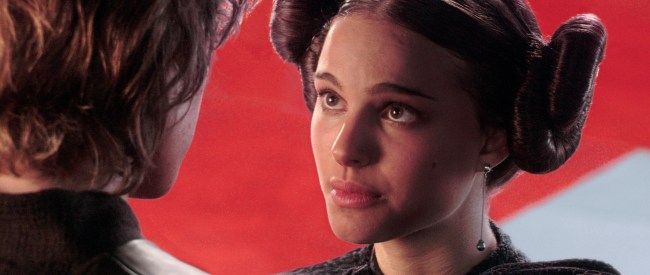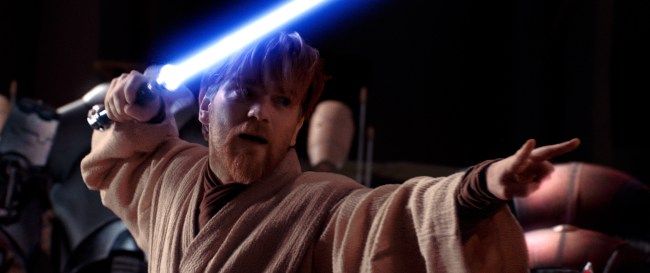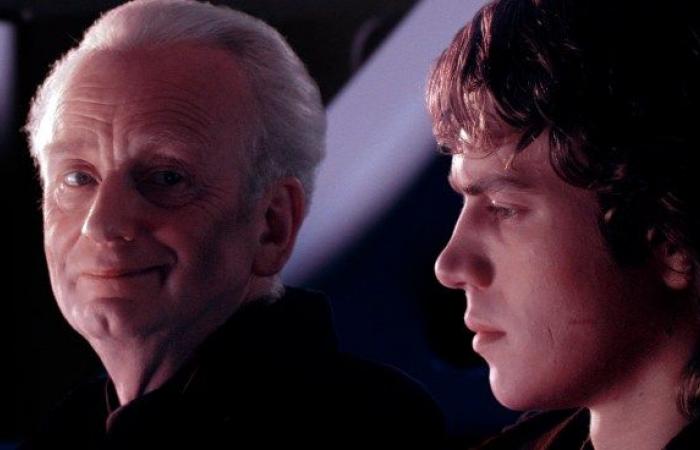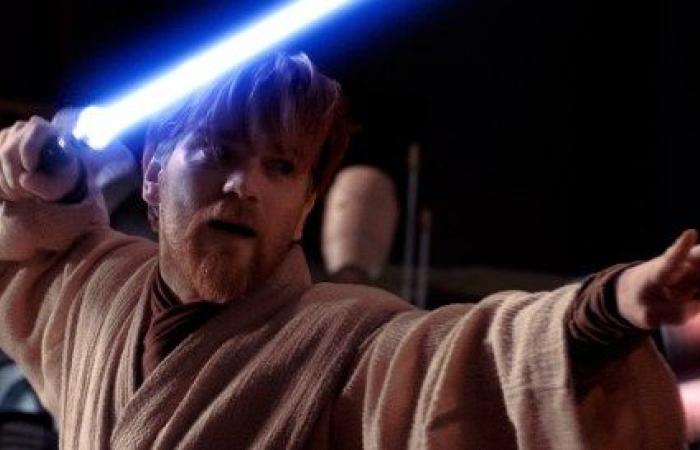Only a Sith deals in absolutes, but “Star Wars” fans love to deal with hyperbole.
This fan has such a declaration to make: “Star Wars: Episode III — Revenge of the Sith” is the best “Star Wars” movie of all. It is as personal a blockbuster film as you’ll find this century, a work of operatic grandeur and daring and despair that built on every “Star Wars” movie before it to deliver a final statement. Well, a final statement for George Lucas, at least, who folded up his director’s chair once and for all after “Revenge” hit theaters in 2005.
Over the past 10 years, since Disney took over the franchise and unspooled its galaxy’s worth of films and TV shows set in the “Star Wars” universe, the prequels have received an approval-ratings boost. The cynics will say that the prequels haven’t changed, it’s just a matter of how disappointing much of Disney’s offerings have been. I’m here to say, that the critics and “fans” who hated the prequels, especially “Revenge of the Sith,” were wrong all along. “Revenge” was great in 2005 — I already said it was one of the 10 best films of the 21st century for BBC Culture in 2016 — and it’s even better now. And not just because real world events have mirrored galactic events.
The biggest charge against the prequels was a conceptual one: They merely filled in details within the broad strokes outline we already knew — that Darth Vader needed his suit because he’d been horribly injured in a volcano was established in the “Return of the Jedi” novelization in 1983. There was no ending being newly revealed when the end credits for “Revenge of the Sith” rolled. That conceptual basis is actually the secret strength of the prequels, with the emphasis being not on “what happened” but “how things happened.” And with “Revenge of the Sith,” the big takeaway is not “that’s how it ends,” but “here’s what it all means.” The prequels make the original trilogy that much richer, because they add meaning: They tell you that much more why the original films mattered all along.
And with “Revenge of the Sith,” Lucas gave his boldest philosophical Take: That the same qualities that make a hero can make them the vilest villain. That the institutions you cling to can crumble in a moment, faster than the Death Star pulverizing a planet. That the key to winning a battle may in fact be… not fighting a war at all. That absolutes may not hold much value at all. Not even the distinction between the Dark Side and the light Side of the Force.

Take a look at the scene that’s the heart of the film in so many ways: When co-leader of the Jedi Order Mace Windu takes three Jedi with him to arrest Chancellor Palpatine at his office. Ian McDiarmid finally gets the chance to take the mask off as the would-be Emperor and reveals the character’s full, snarling villainy. Murdering Mace’s three colleagues before they barely have a chance to defend themselves, Palpatine seems to have the upper hand — but Mace is in the position he’s in for a reason, and he disarms the Chancellor. Holding his purple lightsaber at Palpatine’s throat, Mace tells Anakin Skywalker that the Chancellor “is too dangerous to be left to the courts” and that this will end “here and now.” The leader of the Jedi Order is literally going to assassinate the unarmed Chancellor. It’s all true what Palpatine said about the Jedi wanting to take over!
Now you know and I know that the Jedi wouldn’t have then plunged the galaxy into darkness and created the Empire if they had killed Palpatine there. But committing an assassination in order to serve your stated goal of restoring democracy… doesn’t that mean you’ve already lost? Whatever government you’d put in place then would be forever stained with murder, born in blood, no matter how noble its eventual intentions might be. Palpatine wins and becomes emperor because he’s forced the Jedi to become their worst selves, to, unlike Obi-Wan later in the film, surrender their moral high ground. Maybe killing Palpatine there meant the Jedi couldn’t lose. But they’d never be able to win, either.
Of course, being an autocrat, Palpatine will use this attempt on his life to justify actually slaughtering thousands of Jedi. The way of all autocrats: They don’t just commit their barbarities, they feel morally justified, even worthy, in doing so. There’s an indignation McDiarmid conveys in these scenes after the attempt on his life that’s especially potent: How dare you make me have to commit unspeakable horrors?
For those, who buy in with fascism, it’s a simple calculus: Well, you who oppose us would do this to us if you had the chance, right?
McDiarmid’s work here is spectacular, pushing beyond any measure of realism, until he’s playing the part of the Emperor, scarred face under hood and all, like he’s the evil queen turned hag in Disney’s “Snow White and the Seven Dwarfs.” Visually, they couldn’t be more similar. But it’s a mark of Lucas’s fair-mindedness that he recognizes it’s far more likely for an old man to be the villain in a situation like this than an old woman, even with fairy tale logic underpinning much here. (A similar reversal occurs courtesy of Western iconography in “A new Hope,” when the Jawa settlers are not massacred by the “native” people, the Tusken Raiders, but by the forces of the Empire, who cover their tracks by pinning the blame on the Tuskens.) Needless to say, there’s a reason why IndieWire chose McDiarmid’s turn here as one of the best performances of the 2000s.
These political ideas about the guilt and savior complexes underpinning fascism come straight from the 1930s, the era in which the “Flash Gordon” serial (complete with the opening crawl) that inspired Lucas so much, first unspooled in movie projectors around the world. What’s extraordinary is that Lucas married them with the most up to the minute technology, concerned as he was with making sure each “Star Wars” installment pushed the boundaries of film form. “Revenge of the Sith” utterly rejects any attempt at naturalism. It’s an exercise in pure style, where the actors are almost entirely filmed in front of blue screens — meaning that McDiarmid and Ewan McGregor, as actors with a strong theater background, where imagining things that aren’t there is a given, particularly excelled. Film fans may have forgotten this but there was even some chatter in 2005 about whether “Revenge of the Sith” might even meet the Academy’s definition of an animated film.
Lucas and his VFX animators paint with pixels in “Revenge of the Sith.” If you’re a revanchist who stumps for the Wachowskis’ “Speed Racer,” you need to get on a soapbox for “Revenge” too. Both of these movies glimpse the eternal through a scrim of pure artifice, where every last aspect of the frame is controlled by its author. It especially works in “Revenge,” because of how Lucas luxuriates in his pixel landscapes, letting you as the audience just “be” in that galaxy far, far away for a bit.
Take the 56-second scene where you’re simply watching general Grievous’s ship fly through space, enter the atmosphere of the planet Utapau, and then come for a landing in a sinkhole city, where the cyborg general walks out coughing to go dial up Palpatine over the holonet. Nothing really happens here! It’s just an interlude, using opera as a metaphor, to catch your breath while the scenery is being moved around on stage, and to bathe for a bit in John Williams’ haunting “dies irae” chorus.
That is worldbuilding. Environments aren’t being explained, but you’re inherently encouraged to rove your eyes over the frame and explore. And it must be said that there are almost no moments like that in the “Star Wars” stories that have been told since Lucas’s exit. Most of these post-Lucas stories are simply told, and don’t invite you in to discover on your own (on the other hand, the first genuine “stop the action and deliver exposition” scene occurs more than a half hour into “A New Hope,” that’s how much that movie just “drops you in” and forces you yourself to get your bearings).

Lucas’s particular sense of quirk adds detail and personality throughout as well: Grievous’s unexplained cough, the extreme close-ups of Grievous and Obi-Wan’s eyes in their duel, the moment a blaster bolt almost hits Yoda while he’s observing a battle on Kashyyyk from afar, “good relations with the Wookiees I have.” The humor in “Star Wars” under Lucas is the closest thing American cinema has to British humor: deadpan, unexplained, presented as “take it or leave it.”
“Revenge of the Sith” stands as a testament to all that’s been lost since: Instead of pushing boundaries and embracing the artifice of the digital revolution, the films in the franchise since have embraced throwback technology and all but thrown VFX artists under the bus. The “practical effects” mantra J.J. Abrams threw out there constantly in the marketing campaign for “The Force Awakens” was a sign that “Star Wars” might not be interested in breaking new ground any longer, but simply looking to the past. It has a couple moments of Lucasian humor — the sandworm peeking around to look at BB-8 trundle off into the desert is one, but something like Finn holding up the training remote aboard the Millennium Falcon is the kind of wink-wink, nudge-nudge “remember this?” smarm Lucas would never have engaged in. The most he would do would be, like, “Club Obi-Wan.”
The moral murk of “Revenge of the Sith,” its particular deconstruction of the entire Manichaean, dark vs. light ethos of the “Star Wars” saga, is so much more profound than even in “The Last Jedi,” held up by both supporters and detractors as the most radical “Star Wars” film made since. When Luke contemplates for an instant killing his nephew Ben, it’s just for an instant — unlike Mace Windu outright embracing murder. By the end of “The Last Jedi,” the Jedi as an idea are as pure and holy and worthy as anything in cinema could ever be, not the fallen enablers of fascism they are in “Revenge of the Sith.”
Lucas’s final film is a kind of elegy for an entire style of personal blockbuster filmmaking, Williams’ funeral music in the last moments fitting for the director’s last moments behind the camera. His franchise would become just that, a franchise, in the years ahead, no longer a series of films that bear a personal signature from a singular creator capable of imagining a whole galaxy. There have been good moments since, and bad. But before he handed over the reins, Lucas made a final statement with “Revenge of the Sith” that his saga was really about something. It didn’t just exist to sell toys. It was about how good people become evil — actively choose to become evil — and the justifications they make along the way.
These stories mattered. They do matter. With his final turn behind the camera, Lucas showed us why.










